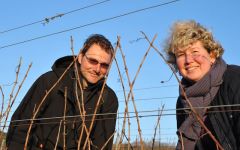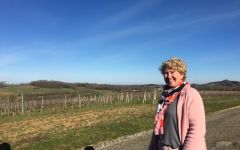Champ Divin Chardonnay 2020



Product Details
Your Rating
Somm Note
Winemaker Notes
Champ Divin’s cuvée of chardonnay is fresh and delicate; notes of pear, along with hints of yellow peaches and biscuit on a finely tuned finish. A delicious and very approachable example of Jurassien Chardonnay.



Fabrice and Valerie Closset-Gaziaux both have educational backgrounds in agronomy and earth sciences. After having spent extensive time working to develop sustainable farming practices in Africa and then helping growers in the Loire develop organic and naturally balanced vineyards for 8 years, they decided (in 2008) to procure vineyards in South-Revermont, in the “premier plateau” of Jura.
Fabrice and Valerie acquired 5 hectares of land on which they grow Pinot Noir, Chardonnay and Savagnin and employ biodynamic farming practices. They emphasize patience and observance as two necessary principles for understanding their locale, and learning from their sites to better accommodate a balance in the vineyard.

One of the most popular and versatile white wine grapes, Chardonnay offers a wide range of flavors and styles depending on where it is grown and how it is made. While it tends to flourish in most environments, Chardonnay from its Burgundian homeland produces some of the most remarkable and longest lived examples. California produces both oaky, buttery styles and leaner, European-inspired wines. Somm Secret—The Burgundian subregion of Chablis, while typically using older oak barrels, produces a bright style similar to the unoaked style. Anyone who doesn't like oaky Chardonnay would likely enjoy Chablis.

On the foothills of the Jura Mountains, just east of the Cote de Beaune on the Switzerland border, the Jura wine-producing zone is recognized for its unique reds, as well as its particular and diverse styles of whites.
Though borrowed from their neighbor Burgundy, Chardonnay and Pinot noir have been growing in Jura since the Middle Ages. But here the altitude, topography, climate and clay-rich, marl soils support a different style of Pinot noir, not to mention its other deeply-colored, full-bodied indigenous reds, Poulsard and Trousseau.
Considering area under vine, growers here favor Chardonnay for its consistency and reliability; it comprises almost half of Jura's vineyard acreage. However, Jura Chardonnay is anything but boring; its many offbeat styles are part of what make region’s wines so distinctive. It is used for Cremant (sparkling), Macvin (a fortified wine), as well as fine examples at the quality level of Burgundy.
Jura also has a unique oxidative style for Chardonnay but is better recognized for its similarly-styled “vin jaune,” meaning ‘yellow wine,’ which is made from the indigenous variety, Savagnin. Vin jaune is made using techniques similar to those used to make Sherry.
For all of its wines, Jura favors a traditional, natural and often organic style in viticulture and winemaking.
